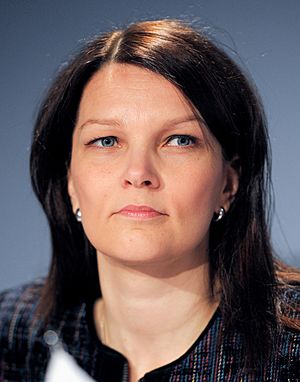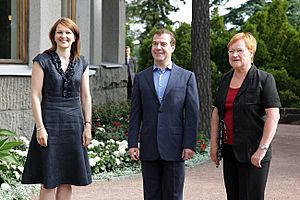Mari Kiviniemi facts for kids
Quick facts for kids
Mari Kiviniemi
|
|
|---|---|

Kiviniemi in 2010
|
|
| 41st Prime Minister of Finland | |
| In office 22 June 2010 – 22 June 2011 |
|
| President | Tarja Halonen |
| Deputy | Jyrki Katainen |
| Preceded by | Matti Vanhanen |
| Succeeded by | Jyrki Katainen |
| Minister for Public Administration and Local Government | |
| In office 19 April 2007 – 22 June 2010 |
|
| Prime Minister | Matti Vanhanen |
| Preceded by | Position established |
| Succeeded by | Tapani Tölli |
| Minister for Foreign Trade and International Development Acting |
|
| In office 3 September 2005 – 2 March 2006 |
|
| Prime Minister | Matti Vanhanen |
| Preceded by | Paula Lehtomäki |
| Succeeded by | Paula Lehtomäki |
| Leader of the Centre Party | |
| In office 12 June 2010 – 9 June 2012 |
|
| Preceded by | Matti Vanhanen |
| Succeeded by | Juha Sipilä |
| Member of the Finnish Parliament | |
| In office 24 March 1995 – 22 September 2014 |
|
| Constituency | Helsinki |
| Personal details | |
| Born |
Mari Johanna Kiviniemi
27 September 1968 Seinäjoki, Finland |
| Political party | Centre |
| Spouse |
Juha Louhivuori
(m. 1996) |
| Children | 2 |
| Alma mater | University of Helsinki |
Mari Johanna Kiviniemi (born 27 September 1968) is a Finnish politician. She was the 41st and second female Prime Minister of Finland from 2010 to 2011.
Since August 25, 2014, she has served as the Deputy Secretary-General of the OECD. The OECD is an international group that works to build better policies for better lives.
Contents
Early Life and Education
Mari Kiviniemi was born in Seinäjoki, Finland. She grew up in a farming area called Southern Ostrobothnia. Her father was a chicken farmer. She went to school in Jalasjärvi.
When she was a teenager in high school, she spent a year studying in Germany as an exchange student. In 1988, she started studying economics at the University of Helsinki.
Political Career
Mari Kiviniemi has spent her career in politics. She first tried to become a Member of Parliament in 1991. At that time, she was the leader of the Centre Party's student group.
After finishing her master's degree in Social Sciences, she ran for Parliament again in 1995. This time, she won a seat representing the Southern Ostrobothnia area.
Besides her work in national politics, Kiviniemi was also a member of the Helsinki city council. She served on the city council starting in 2005.
Becoming a Party Leader

In 2003, Mari Kiviniemi was chosen for a leadership role in the Centre Party. She was one of three vice-chairpersons until June 2008.
In 2004, she became a special advisor to the Prime Minister, Matti Vanhanen. He later appointed her as a government minister twice. First, she served temporarily in September 2005 for six months. Then, she became a full-time minister in April 2007.
On January 22, 2010, Prime Minister Vanhanen announced he would step down as the Centre Party leader. Mari Kiviniemi then announced she would run for the position. Her campaign officially started in April.
The Centre Party members met in Lahti on June 12, 2010, to choose a new leader. Mari Kiviniemi won the election. She defeated Mauri Pekkarinen in the second round of voting.
Prime Minister Vanhanen resigned on June 18. Mari Kiviniemi's new role as Prime Minister was approved by the Finnish Parliament on June 22, 2010. She became Finland's second female Prime Minister. The first was Anneli Jäätteenmäki in 2003.
The 2011 Election and After
The 2011 Finnish parliamentary election brought big changes. A new party, the True Finns, gained many seats. Mari Kiviniemi's Centre Party lost 16 of its 51 seats. It went from being the largest party to the fourth largest.
Initially, Kiviniemi said her party would not join the next government. However, she later accepted an invitation to discuss forming a government with Jyrki Katainen. These talks did not work out. Six other parties then agreed to form a government.
On June 22, 2011, Mari Kiviniemi presented her government's resignation to the President. Jyrki Katainen officially became the new Prime Minister. The Centre Party then became an opposition party, meaning they were not part of the government. Kiviniemi continued as the party's leader.
Stepping Down as Party Leader
After new polls showed that the Centre Party was not gaining more support, Mari Kiviniemi decided to step down as chairperson. She did not run in the party's leadership election in the summer of 2012. Juha Sipilä became the new leader of the Centre Party.
Kiviniemi explained her decision to the media. She felt the party had done good work in opposition. However, if support in the polls did not increase, she believed she should take responsibility. She stated that party work requires a lot from everyone, especially the leader.
Role at the OECD
Mari Kiviniemi started her job as the Deputy Secretary-General of the OECD on August 25, 2014. In this role, she uses her experience to help the OECD's work have a greater impact. She helps with important public policy challenges. These include promoting economic growth that benefits everyone, creating jobs, and increasing trust.
She helps oversee the OECD's work on good governance, regional development, trade, agriculture, and statistics. She also helps advance the Better Life Initiative, which focuses on improving people's well-being.
Personal Life
Mari Kiviniemi married Juha Mikael Louhivuori, a businessman, in 1996. They have two children, Hanna and Antti. Besides her native Finnish language, she also speaks Swedish language, German language, and English language.
Her hobbies include listening to classical music. She plays the piano and flute. She also enjoys running, skiing, and in-line rollerblading. Her family has a summer cottage on Lake Vanajavesi.
Cabinets
- Kiviniemi Cabinet (2010–2011)
See also
 In Spanish: Mari Kiviniemi para niños
In Spanish: Mari Kiviniemi para niños

